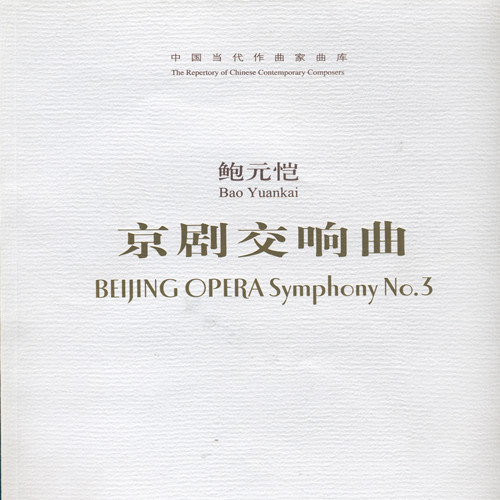基本介紹
- 書名:京劇交響曲
- 作者:鮑元愷
- ISBN:9787103035689、7103035687
- 頁數: 124頁
- 出版社:人民音樂出版社
- 出版時間:2008年12月1日
- 裝幀:平裝
作者簡介,內容簡介,
作者簡介
鮑元愷(1944——)作曲家、音樂教育家。1967年畢業於中央音樂學院作曲系,1973年到天津音樂學院任教。現任天津音樂學院教授、廈門大學藝術研究所所長。歷任中國音樂家協會創作委員會副主任、《音樂研究》編委、金鐘獎音樂作品評審。是首批獲得國務院特殊津貼的專家,2005年獲區永熙優秀音樂教育獎,2012年獲廈門大學最高獎“南強獎”。作有《炎黃風情——中國民歌主題24首管弦樂曲》(1991)、《華夏弦韻》室內樂集(2001)、六部交響曲:《紀念》(2004)、《台灣音畫》(1996 / 2000 / 2006)、《京劇》(2006)、《廈門》(2008)、《禹王》(2009)、《燕趙》(2012)以及童聲合唱套曲《四季》(1980)、《景頗童謠》(1981)等。作品多次在海峽兩岸各大城市和亞洲、大洋洲、南北美洲、東西歐洲和南非,由國內外交響樂團演出,並由DG、EMI、PHILIPS、DECCA、雨果等多家機構出版唱片。
Professor BAO Yuankai
(1944—--),composer and music educator, graduated from Beijing Central Conservatory of Music in 1967. He has been working at the Tianjin Conservatory of Music since 1973. He also serves as the deputy director of the Composition Committee of the Chinese Musicians Association, the director of Institute of Arts at Xiamen University. He was member of Music Research(one of the major academic journals in the country) as well as a member of the panel of judges for the composition competition “Golden Bell Awards”. In recognition of his dedication and achievements towards music education and composition, Prof. Bao was one of the first music educators to receive the special grant from the Chinese State Council and the“Outstanding Music Educator” award from the Chinese Ministry of Culture.
Prof. Bao's compositions include
Chinese Sights and Sounds, 24 Pieces on Chinese Folk tunes for Orchestra (1991)
Chinese Melody of the Strings, Quartet Series Arranged by Chinese traditional music (2001)
Symphony No.1, Commemoration (2004)
Symphony No.2, Sketches of Taiwan (1996 / 2000 / 2006)
Symphony No.3, Peking Opera (2006)
Symphony No.4, Amoy (2008)
Symphony No.5, The King Yu (2009)
Symphony No.6, Yan Zhao (2012)
Children's Chorus The Seasons (1980) and Jingpo Nationality Children's Folk Rhyme (1981).
His recordings have been released by DG, EMI,PHILIPS, DECCA,and HUGO.
內容簡介
鮑元愷第三交響曲——京劇,Bao Yuankai Symphony No.3,Peking Opera,2006,雙管交響樂團。2006年5月在北京試演。2006年9月2日譚利華指揮北京交響樂團在北京中山音樂堂首演。2007年3月EMI發行發行唱片。2008年人民音樂出版社出版總譜。41:45。
a Solemn Andante using Kun-Qu music 12:01
a Humorous Presto using Qu-Pai music 5:06
a Profound Largo using Er-Huang music 12:00
a Splendour Allegro using Xi-Pi Music 12:37
這部交響曲是作曲家應北京交響樂團之約,於2005年11月開始創作,2006年5月在北京試演。9月2日在北京交響樂團的2006-2007音樂季開幕式上正式首演。
這部交響曲以京劇中不同角色不同性格的音樂為基礎,以西方交響樂的恢宏氣勢和藝術手段,努力揭示中華民族深刻、豐富的精神世界。
京劇的角色,分為生、旦、淨、醜四類;京劇音樂,除了獨立的鑼鼓音樂外,主要由西皮、二黃、曲牌和崑曲四部分組成;典型的交響曲,由不同速度、不同節拍和不同性格的四個樂章組成;演奏交響樂的管弦樂隊,則由弦樂、木管、銅管和打擊樂四個部分組成。據此,將《京劇》交響曲分為“淨——悲壯的行板——崑曲”“醜——詼諧的急板——曲牌”“旦——深沉的慢板——二黃”“生——輝煌的快板——西皮”四個樂章。
以下文字摘自馬浩(啥都中)《京劇+交響樂=中國巴托克》:
《京劇》,一部中規中矩的四樂章交響曲作品。以典型京劇音樂為素材與背景,生旦淨醜各成一章,打擊樂,弦樂,銅管樂,木管樂分別表現其特色意境。立意巧妙,素材豐盈,結構嚴謹,旋律舒通,技法嫻熟,配器天成,細節精到,氣勢恢弘。
第一樂章。悲壯的行板。淨。崑腔。以銅管樂為主,展現淨行的氣派。豪邁浪漫,蒼涼悲壯,從遠古走來,奔向遠方。英雄氣概,俠膽柔腸。大寫意,好寬廣,豐厚凝重,高亢激昂,悠揚婉轉,盪氣迴腸。
第二樂章。詼諧的急版。醜。曲牌。以木管樂為主,捕捉醜行的意韻。詼諧乖巧,風趣幽默,看人間世事,哀樂幾多。悠然行走,憨態活脫。時智趣,時呆傻,插科打諢,冒失攪和,逡巡四顧,洋洋自得。
第三樂章。深沉的慢板。旦。二黃。獨用弦樂擔綱,描繪青衣之情致。淒楚哀怨,悱惻纏綿,聽衷腸傾訴,真情盡現。意氣賢淑,儀態萬般。可清麗,可端莊,秋波晶瑩,玉體翩翩,水袖輕搖,韻致嫣然。
第四樂章。輝煌的快板。生。西皮。以打擊樂為主,高揚生行之神采。煌煌大度,氣魄絕凡,能縱橫俾合,傲立世間。揮灑自如,鎮定坦然。亦睿智,亦果敢,躊躇滿志,談笑陣前,縱論人生,立地頂天。 《京劇交響曲》反映當代中國專業音樂創作成就和整體發展水平,以西方交響樂的創作手法深刻表現出中華民族特有的精神世界。並在書後附音頻光碟。
鮑元愷第三交響曲《京劇》中文說明
鮑元愷的第三交響曲《京劇》,以京劇中不同角色不同性格的音樂為基礎,以西方交響樂的恢宏氣勢和藝術手段,揭示了中華民族深刻、豐富的精神世界。
京劇的角色,分為生、旦、淨、醜四類;
京劇音樂,除了獨立的打擊樂段落外,主要由西皮、二黃、曲牌和崑曲四部分組成;
典型的交響曲,由不同速度、不同節拍和不同性格的四個樂章組成;
演奏交響樂的管弦樂隊,則由弦樂、木管、銅管和打擊樂四個部分組成。
據此,作曲家將《京劇》交響曲分為如下四個樂章:
第一樂章,悲壯的行板,淨,崑腔,突出銅管樂器。主題取自京劇《單刀會》中關羽的崑曲唱段《大江東去》。
第二樂章,詼諧的急板,醜,曲牌,突出木管樂器。諧謔曲的引子和中部主要旋律來自京劇中的曲牌(器樂曲)《柳青娘》,首尾兩部分帕薩卡里亞的三拍子固定低音主題來自京劇中人物走場的“行弦”。
第三樂章,深沉的慢板,旦,二黃,全部使用弦樂。主題來自京劇《白蛇傳》中女主角與孩子別離時淒婉悲傷的唱段。
第四樂章,輝煌的快板,生,西皮,突出打擊樂,並輪流使用樂隊各組樂器的多種組合。快板奏鳴曲式,主部主題的音調來自“西皮小開門”,副部旋律來自京劇《空城計》中諸葛亮的膾炙人口的西皮二六唱段。
這部《京劇》交響曲由北京交響樂團委託作曲家鮑元愷創作。2006年5月23日由譚利華指揮北京交響樂團舉行世界首演。
鮑元愷第三交響曲《京劇》英文說明
China’s traditional opera is an ancient drama form. which blends the different elements of literature, music, dance, visual arts, martial arts, acrobatics and other forms of performance art. Peking opera, which is named after the capital of China, is the most influential and popular of this family of localized drama forms. Bao Yuan-Kai’s third symphony “Peking Opera” employs the various roles and musical styles found in the drama form. and attempts to display the profound and rich spiritual world of the Chinese through the western art form. of the symphony.
The roles in Peking Opera are divided into four categories:Sheng- The Male,Dan- the Female,Jing- the Painted Face, which is a forceful character in the drama, andChou- the Comedian.
The music of Peking Opera is usually a combination of stand alone percussion sequences and four musical styles:Xi-Pi,Er-Huang(these two are usually used for sung passages),Qu-Pai(which means fixed tuned music and usually is in the form. of instrumental passages which are used as background music) andKun-Qu(borrowed from another drama form. popular in the Eastern regions of China).
A typical symphony is composed of four movements with different speeds, tempos and character. A symphonic orchestra consists of four sections: strings, woodwind, brass and percussion.
Hence the composer has produced his music as follows:
Movement 1:Jing– The Painted Face, A solemnAndanteusingKun-Qumusic.This movement showcases the brass section, with the motif adapted from General Guan Yu’sKun-Qustyled aria “On and on the great river flows, racing eastwards” in the play “The Lone Broadsword”.
Movement 2:Chou– The Comedian, A humorousPrestousingQu-Paimusic.This movement showcases the woodwinds. The introduction to theScherzoand the main melody of the middle section comes from the Peking OperaQu-Paiof “The green willow lady” and the 3/4 timeBasso ostinatofound at the beginning and end of the movement comes from theQu-Pai“Walking Strings” which is usually used as the background music when a Peking Opera character moves around the stage.
Movement 3:Dan– The Lady, A profoundLargousingEr-Huangmusic.This movement employs only the strings. The main theme comes from the plaintive but lovely passage sung by the main female role of the play “The Legend of Lady White Snake” when she had to part with her son.
Movement 4:Sheng– The Man, A splendorAllegrousingXi-Pimusic.This movement emphasizes the use of the percussion instruments and employs the varied combinations of different sections of the orchestra in a fast paced Sonata form. conclusion to the symphony. The principal theme comes from aXi-Pitune and the secondary theme comes from a famous passage sung by the wise military advisorZhu-Ge Liangin the play “The Empty Castle Trick”
This symphony was commissioned by the Beijing Symphony Orchestra and premiered on 23rd day May 2006 by conductor Tan Lihua in Beijing..
Translated by: Tan Ke-Yang

